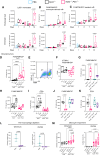PTEN Loss Shapes Macrophage Dynamics in High-Grade Serous Ovarian Carcinoma
- PMID: 39186679
- PMCID: PMC7616669
- DOI: 10.1158/0008-5472.CAN-23-3890
PTEN Loss Shapes Macrophage Dynamics in High-Grade Serous Ovarian Carcinoma
Abstract
High-grade serous ovarian carcinoma (HGSC) remains a disease with poor prognosis that is unresponsive to current immune checkpoint inhibitors. Although PI3K pathway alterations, such as PTEN loss, are common in HGSC, attempts to target this pathway have been unsuccessful. We hypothesized that aberrant PI3K pathway activation may alter the HGSC immune microenvironment and present a targeting opportunity. Single-cell RNA sequencing identified populations of resident macrophages specific to Pten-null omental tumors in murine models, which were confirmed by flow cytometry. These macrophages were derived from peritoneal fluid macrophages and exhibited a unique gene expression program, marked by high expression of the enzyme heme oxygenase-1 (HMOX1). Targeting resident peritoneal macrophages prevented the appearance of HMOX1hi macrophages and reduced tumor growth. In addition, direct inhibition of HMOX1 extended survival in vivo. RNA sequencing identified IL33 in Pten-null tumor cells as a likely candidate driver, leading to the appearance of HMOX1hi macrophages. Human HGSC tumors also contained HMOX1hi macrophages with a corresponding gene expression program. Moreover, the presence of these macrophages was correlated with activated tumoral PI3K/mTOR signaling and poor overall survival in patients with HGSC. In contrast, tumors with low numbers of HMOX1hi macrophages were marked by increased adaptive immune response gene expression. These data suggest targeting HMOX1hi macrophages as a potential therapeutic strategy for treating poor prognosis HGSC. Significance: Macrophages with elevated HMOX1 expression are enriched in PTEN-deficient high-grade serous ovarian carcinoma, promote tumor growth, and represent a potential therapeutic target.
©2024 The Authors; Published by the American Association for Cancer Research.
Conflict of interest statement
S. Spear reports receiving salary and research consumable support through a grant from the charity Ovarian Cancer Action, reference PSF687. O. Le Saux reports grants from AstraZeneca and Bristol Myers Squibb outside the submitted work. J.D. Brenton reports grants from Cancer Research UK during the conduct of the study, as well as personal fees and other support from Tailor Bio Ltd. and personal fees from GSK, GE Healthcare, and Clovis Oncology outside the submitted work. B.C. Vanderhyden reports grants from Ovarian Cancer Canada outside the submitted work. I.A. McNeish reports grants from Ovarian Cancer Action and Cancer Research UK, grants and personal fees from AstraZeneca, and personal fees from GSK, pharma&, Clovis Oncology, Roche, BioNTech, OncoC4, and Duke Street Bio outside the submitted work. No disclosures were reported by the other authors.
Figures







References
-
- Ray-Coquard I, Pautier P, Pignata S, Pérol D, González-Martín A, Berger R, et al. . Olaparib plus bevacizumab as first-line maintenance in ovarian cancer. N Engl J Med 2019;381:2416–28. - PubMed
-
- Zhang L, Conejo-Garcia JR, Katsaros D, Gimotty PA, Massobrio M, Regnani G, et al. . Intratumoral T cells, recurrence, and survival in epithelial ovarian cancer. N Engl J Med 2003;348:203–13. - PubMed
MeSH terms
Substances
Grants and funding
LinkOut - more resources
Full Text Sources
Medical
Research Materials
Miscellaneous

